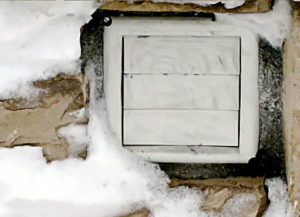Dryer Vents and Carbon Monoxide
 Ice-covered dryer vent
Ice-covered dryer vent
Snow and Ice Covered Dryer Vents Cause Homeowner Headaches
Blocked clothes dryer vents with snow or ice are more than a nuisance. Ice forms and builds up around the outside of your dryer vents. The iced-over flaps need to be cleared.
The lint, dust, and other debris typically get carried away from your clothes. They should exit your house but get trapped inside the dryer and vent. Serious problems can occur if your dryer vent exits your home in an area prone to snow cover or water runoff.
For example, snow drifts off the roof and can quickly accumulate several feet high, covering the dryer vent below. Snow not only enters the duct, but it can also freeze over.
Blocked Vent Cause Carbon Monoxide (CO)
Perhaps the most harmful effect of a snow-covered or ice-blocked vent stems from carbon monoxide (CO). This gas gets trapped within the gas dryer and released back into your home or salon.
Although carbon monoxide buildup and exposure are not hazards with electric dryers, they can overheat! Exposure to the gas can lead to health problems, including headaches and dizziness. Prolonged carbon monoxide exposure can even lead to death.
Gas dryers must be checked after every snowstorm or deep freeze to ensure they are venting properly.
Blocked dryer vents waste energy because your dryer has to work harder to dry your clothes. A clogged dryer vent causes lint to build up. Snow and ice can prevent the dryer’s vent flapper from opening correctly, preventing cooler air into the appliance.
4 Signs Of A Blocked Dryer Vent!
Four signs your dryer vent is blocked by snow or ice
- Increased dryer time. If you notice your dryer taking longer than usual to dry your clothes
- Your clothes feel hot to the touch.
- Lint blowing out into your room or settling on your clean clothes.
- The lint is settling on the inside and the dryer’s back panel.
If you are concerned that your dryer vents may be clogged due to excessive snow and ice buildup, please get in touch with us at (847) 874-4805 to have a trained technician from The Lint King remove the snow around your dryer vent inspect and clean your dryer vent and ensure your dryer is safe to operate and free from Blocked Dryer Vent and Carbon Monoxide.
Your 100% satisfaction is our most significant concern.
 Northern Illinois Dryer Vent Cleaning | The Lint king
Northern Illinois Dryer Vent Cleaning | The Lint king